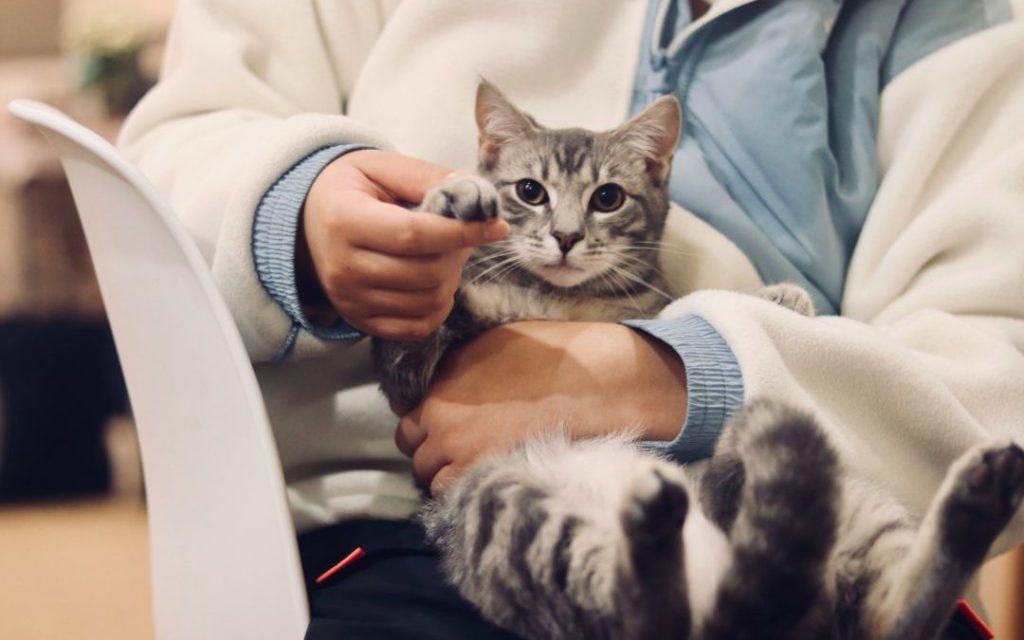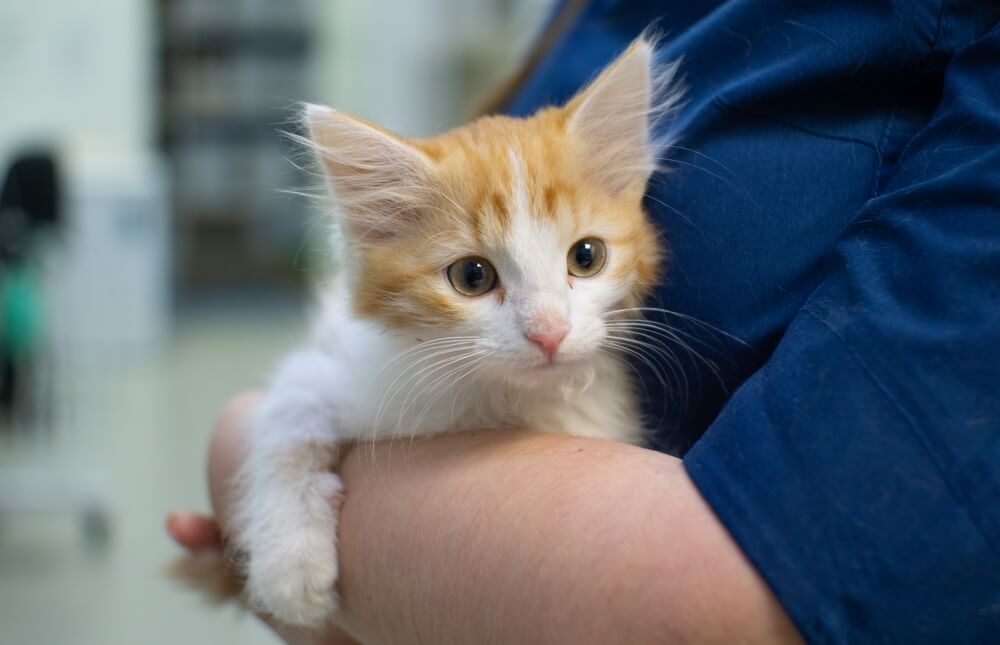Taking a fearful and possibly sick cat to the pet doctor often results in stress for humans and animals. For your cat, a visit to the pet doctor means that he has to leave his usual surroundings. This fact alone causes stress in cats, as our cats are sensitive creatures of habit and they are reluctant to leave their territory. Your cat is already afraid of the transport box and at the pet doctor it is aggressive and literally panics? We’ll give you tips on how you can take your cat to the pet doctor in a more stress-free and relaxed manner.
Table of Contents
When should the cat’s first vet visit take place?
A kitten should be taken to the veterinary clinic for the first time at eight weeks of age, then the first vaccination is due and a thorough examination is carried out. Get your cat used to examinations from an early age. If she has good experiences at a young age, visits to the pet doctor will usually go smoothly later in her life.

The first visit to the vet with the cat: This is how it works
The topic of vaccination plays a particularly important role in preventive examinations. Vaccination protection is a compulsory treatment, especially for kittens. Therefore, make sure that your cat is basic immunized at a young age. This includes vaccinations against cat flu and cat disease in the first eight weeks of life. Vaccination against leukemia and, in outdoor animals, against rabies is particularly important. The latter two should be repeated annually to ensure lifelong vaccination protection. Further information about Rabies vaccination for cats you can find it here.
A comprehensive examination also includes systematic palpation of your cat and listening to its heart and lungs. During preventive care, the cat’s teeth and head should also be thoroughly examined, body weight recorded and joint mobility checked. In addition, a urine sample and a complete blood count are recommended for older cats.
Regular veterinary visits with your cat are mandatory to ensure that your cat is healthy from top to bottom. When calculating the cost of a cat, you should keep both the purchase and ongoing veterinary costs in mind.

How do I get my cat into the box?
The following tricks can help you take your kitty used to the cat carrier
- Choose the right transport box: Your cat should have enough space in the transport box. Models that can be opened from above are best, so the cat can be removed with less stress. It is ideal if the box also has the option for you to put a hand in the box to keep your cat calm down. Plastic boxes are more hygienic, easier to clean, safer to transport and pose less risk of injury than transport baskets.
- Make the transport box something everyday: Your cat usually associates the transport box with stress and negative feelings if it only knows them from visits to the pet doctor. The best thing to do is to integrate the transport box into your home as an everyday item, put a treat in it every now and then and use it to transport your cat somewhere else so that it becomes familiar to him and he doesn’t become afraid of it.
- Make the transport box comfortable and cozy: For example, put a familiar blanket or pillow inside the carrier – this way the box smells familiar to your cat and he can use it every day as a cozy place to relax, which he can leave again at will. Place a toy in there every now and then. And when you take your cat to the pet doctor, it’s best to line the floor with a towel in case your cat may urinate or defecate out of fear.
- Use sedatives: Spray the carrier with pheromones or put catnip in it. Get advice from veterinarians in advance about what other means you can use to calm your cat.
- Secure the box in the car: So that your cat doesn’t get more scared on the journey and feels safe.
- Give yourself enough time before the vet’s appointment: It’s best if you don’t have to rush to the vet under stress and hecticness, but rather go to the vet timely to calmly lure your cat into the transport box. The more calm you radiate, the more relaxed your cat will be.
This is the best way to prepare for your visit to the vet:
You can and should prepare older and shy feline in particular for the unfamiliar situation. The first thing to do is to find out what stresses your cat the most. For many cats, palpation during treatment is particularly unpleasant. Prevent this stress trigger by petting your cat regularly and also gently touching sensitive areas such as the paws, ears, mouth or stomach. It is also helpful to feel the cat in its usual environment. There she is more willing to be touched and gets used to the examinations. It’s best to place your cat on a smooth surface, like at the pet doctor. If the pet doctor then has to feel her, it is no longer a new situation and does not cause any additional stress. It is also advisable to make initial contact between the animal doctor and the cat without examinations or touching. If the examination date is coming up after the first few exercises, you can reward your cat with treats to ensure that your cat’s pet doctor remembers him positively.

Here are some more tips at a glance:
- Try to avoid stress and hecticness before the vet visit by choosing the ideal appointment and make an appointment as early as possible to avoid lots of strange smells, other animals and long waiting times.
- When you’re driving, talk to your cat calmly if they meow, showing empathy and compassion without increasing their fear.
- Inform your animal doctor in advance if your cat is one of the most anxious cats and let him advise you on the best way to proceed with the appointment.
If you follow our tips and, above all, plan your cat’s visit to the pet doctor carefully in advance, then the biggest stress factor will usually be eliminated. This creates a more relaxed atmosphere that makes your cat feel more comfortable and safe.
Tips to take cat to the vet for the first time
Taking your cat to the pet doctor for the first time can be a stressful experience for both you and your feline friend. However, with some preparation and patience, you can help make the visit as smooth and stress-free as possible. Here are some tips for carrying your cat to the pet doctor for the first time:
- Choose the Right Pet Doctor:
- Before the appointment, research and choose a veterinarian who specializes in treating cats and has experience handling them. Consider factors such as proximity to your home, recommendations from other cat owners, and the clinic’s facilities.
- Get Your Cat Used to the Carrier:
- Start getting your cat comfortable with their carrier well before the pet doctor visit. Leave the carrier out in a familiar and accessible area of your home, and gradually encourage your cat to explore it by placing treats, toys, or bedding inside.
- Practice Car Rides:
- If your cat isn’t accustomed to car rides, take them on short trips around the neighborhood to help them get used to the sensation and sounds of being in a moving vehicle. Use a secure carrier to ensure their safety during the journey.
- Prepare the Carrier:
- On the day of the vet visit, ensure the carrier is clean, comfortable, and securely fastened. Place familiar bedding or a piece of clothing with your scent inside to provide comfort and reassurance to your cat.
- Stay Calm and Positive:
- Cats can pick up on their owner’s emotions, so try to remain calm and composed during the vet visit. Speak to your cat in a soothing tone and offer gentle reassurance throughout the process.
- Bring Necessary Documents:
- Bring any relevant paperwork, such as your cat’s medical records, vaccination history, and microchip information, to the vet appointment. This will help the veterinarian assess your cat’s health and provide appropriate care.
- Arrive Early:
- Arrive at the veterinary clinic a few minutes early to allow time for check-in and paperwork. Avoid rushing, as this can increase stress for both you and your cat.
- Use Calming Aids if Necessary:
- If your cat tends to become anxious or stressed during vet visits, consider using calming aids such as pheromone sprays, calming collars, or natural supplements recommended by your veterinarian.
- Handle with Care:
- When handling your cat at the vet clinic, use gentle and reassuring movements. Avoid restraining them too tightly or forcing them into uncomfortable positions, as this can escalate their anxiety.
- Reward and Reinforce:
- After the vet visit, reward your cat with treats, praise, and extra affection to positively reinforce the experience. This will help create positive associations with future vet visits.
By following these tips and approaches, you can help make your cat’s first vet visit a more positive and less stressful experience for both of you. Remember to be patient, understanding, and supportive of your cat’s needs throughout the process.
FAQs
Q: How should I prepare my cat for a trip to the veterinarian?
A: To prepare your cat for a trip to the veterinarian, start by acclimating your cat to the carrier and the car. You can make the carrier more inviting by placing your cat’s favorite bedding inside and using treats to encourage them to enter. Additionally, you can cover the carrier with a towel or cloth to help your cat feel more secure. Getting your cat used to being in the carrier and going for short rides can help reduce stress on the day of the vet visit.
Q: What should I do in the waiting room at the vet’s office with my cat in the carrier?
A: In the waiting room, it’s necessary to keep the carrier closed to prevent your cat from escaping. You can also try to get your cat used to the sights and sounds of the veterinary office without removing them from the carrier. If your cat panics at the sight of other animals or becomes stressed, you can ask your vet for tips on how to ease your cat’s anxiety in this situation.
Q: How can I make the carrier more comfortable for my cat’s vet visit?
A: You can help your cat feel more comfortable in the carrier by putting a familiar blanket or item of your clothing inside. This will provide a comforting scent and help to calm your cat. It’s also important to ensure that the carrier is secure and stable, so your cat feels safe inside. If your cat is especially anxious, you can speak with the vet tech or veterinary team about ways to make the carrier environment more reassuring for your cat.
Q: Should I bring my cat’s litter box to the vet’s office?
A: It’s a good idea to bring a small, portable litter box with you to the vet’s office, especially if you anticipate a longer wait or anticipate that your cat will be stressed during the visit. This can allow your cat to relieve themselves if they feel the need, and it can help to reduce their anxiety. Keep the carrier securely closed when offering your cat access to the litter box in the waiting room.
Q: How can I keep my cat calm during their vet visit?
A: To help keep your cat calm, you can place a towel or blanket over the carrier to create a dark, calming environment. Additionally, speaking softly to your cat and providing soothing touches can help ease their stress. If your cat is especially anxious, your vet may recommend specific products or techniques, such as pheromone sprays or calming treats, to help your cat remain calm during the visit.